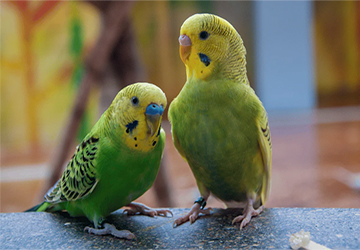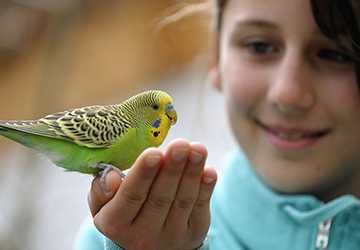The parakeet, also known as a budgerigar or budgerigar, is a cute and charming little bird that can bring joy to any home. However, their sweet chirps can sometimes become a piercing noise that can be disturbing. If you're dealing with a noisy parakeet, don't worry! This article discusses practical training and calming techniques to help you and your feathered friend live harmoniously.
Best tips for caring for noisy parrots:
Through our research, we learned many different ways to keep a noisy parakeet quiet and chose the best and easiest.

Understanding the nature of parakeet noise
Before we delve into training and calming techniques, it's essential to understand why parakeets can be so noisy. Parakeets are social birds with a strong need for communication. In the wild, they rely on vocalizations to stay connected to their flock and establish their presence within their territory. When kept as pets, they often view their human caregivers as part of the group and bond with them through chat.
Provide sufficient stimulation
One of the main reasons parakeets become too noisy is boredom. These intelligent birds require mental and physical stimulation to stay busy and happy. To suppress excessive noise, make sure your parakeet has a stimulating environment:
Toys: Parakeets love toys, especially those that can be chewed or interacted with. Buy toys like bells, mirrors, swings, and puzzles to entertain them.
Rotate: Change toys regularly to prevent boredom. They are less likely to scream for attention when they make a discovery.
Establish a consistent routine
Parakeets thrive on routine, and a predictable routine helps reduce noise. Stick to consistent feeding, playtime, and bedtimes. This way, your parakeet knows what to expect and reduces the need for noticeable vocalizations.
Positive reinforcement training
Training your parakeet is an effective way to control its noise level. Parakeets are intelligent and can learn simple commands through positive reinforcement. How to get started:
Target Training: With target training, your parakeet learns to touch a specific target (stick or finger) in exchange for a reward. You can gradually use this technique to teach your dog other behaviors, such as stepping on your hand or returning to his crate.
Make connections and spend valuable time
Parakeets are highly social birds that thrive on companionship. Spending less time with your parakeet may make him too loud to attract attention. To resolve this issue:
Quality Time: Make time every day to interact with your parakeet. Engage in activities such as talking, playing, or just sitting nearby.
Companion Bird: Consider getting a parakeet as a companion. A feathered friend can significantly reduce loneliness and noise.
Solve health problems
Excessive noise can also be a sign of health problems in your parakeet. If you have tried various training and calming techniques and your parakeet's noises persist, you must consult an avian veterinarian. Health problems such as respiratory infections or discomfort may increase vocalization.
Calming Techniques for Noisy Parakeets
In addition to training, special calming techniques can help reduce noise levels, creating a quieter environment for you and your parakeet.

Provide a quiet retreat
Like all animals, parakeets need a haven when stressed or overwhelmed. Ensure your cage has a cozy corner with some shelter to rest undisturbed. This quiet retreat can be very beneficial when there is a lot of activity or when you have guests over.
Use natural light and darkness
Parakeets have a natural circadian rhythm, meaning they thrive on a day-and-night darkness rhythm. Ensure your parakeet's cage is exposed to natural light during the day and covered at night to provide security. This can help regulate their noise levels.
Play soothing music
Parakeets can benefit from soothing melodies as humans find comfort in music. Soft instrumental music can create a calming atmosphere and help reduce stress-related noise. Avoid loud or disruptive music, as this can have the opposite effect. You might be surprised to learn that some parakeets have different musical preferences. Try different types and see which one your feathered companion likes best. Classical and acoustic melodies are often popular with parakeets, but each bird has its taste in music.
Cover the cage
During boisterous times, such as when your parakeet becomes alarmed by outside noise or environmental changes, covering the cage with a thin cloth can help dampen the noise and create a sense of security. However, using breathable fabrics, such as thin cotton sheets, ensures proper air circulation and prevents overheating. Also, make sure the lid doesn't block all light. Parakeets need some natural light to maintain their circadian rhythm.
Pay attention to external factors
Sometimes, the noise source isn't your parakeet but external factors, such as construction noise, alarms, or noisy neighbors. Try to minimize these distractions by closing windows or using noise-reducing curtains. Move your parakeet's cage to a quieter area of your home, away from the hustle and bustle of daily life. Providing a calm environment for your parakeet can significantly reduce their stress levels, thus reducing their vocalizations. Remember, a quiet living space suits you and your feathered companion.
Diploma
Dealing with noisy parakeets can be challenging, but with patience, understanding, and the proper techniques, you can create a calm living environment for you and your feathered friend. Remember, parakeet noise is a form of communication, and meeting their needs for stimulation, companionship, and training can go a long way toward reducing excessive vocalizations. By following these tips and tricks, you'll be well on your way to enjoying the pleasant company of your parakeet without the nagging.
